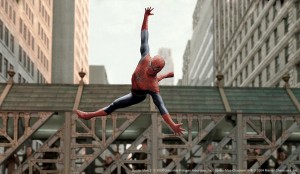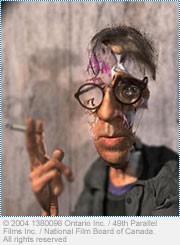The 2004 Visual Effects Oscar was presented as part of the live Oscar broadcast tonight.
Updated.

Jake Gyllenhaal and Ziyi Zhang introduced the nominees for Visual Effects who were standing on stage in a big group – part of the producers plan to save time. I know there was some controversy about this new approach, people felt it could be a slight to the crafts. I felt the way they mixed it up, some in the crowd, some on stage, helped add some variety to the show. I’ll bet family and friends of the nominees would have preferred if the director had chosen to pan the group instead of a wide shot that really did not let you see the nominees faces. Chris Rock would later joke that next year they will be giving out awards in the parking lot.
Anyway, without further delay, the winner of the 2004 Visual Effects Oscar is…
Spider-Man 2
John Dykstra, Scott Stokdyk, Anthony LaMolinara and John Frazier
In his speech John Dykstra said that he was glad there was not a fourth Lord of the Rings film.
the fxguide crew sends congratulations to the brilliant Spider-Man 2 vfx crew and to all the teams that worked on films under consideration this year.

Discreet also issued their congratulations to the winners and pointed out that for the tenth consecutive year discreet clients won the best visual effects Academy Award. Discreet, congratulated post-production facilities Sony Pictures Imageworks (SPI), Zoic Studios, Radium and Ring of Fire on winning the Academy Award® for Achievement in Visual Effects for Spider-Man 2. Discreet also congratulates director Chris Landreth and Copper Heart Entertainment, in co-production with the National Film Board of Canada and in association with the Seneca College Animation Arts Centre, for winning in the Animated Short Film category with Ryan.
ILM’s compositing sequence supervisor Dean Yurke said, “The opening train scene required 61 takes to perfect. The movements of Harry’s body as his soul is being sucked were designed with the inferno system’s 3D geometry, cone vortex, particle and displacement mapping tools. Using the inferno as part of SABRE let us create the ‘extreme’ look that helps make Harry Potter and the Prisoner of Azkaban the scariest of the three Harry Potter films.”.
Cinesite, Moving Picture Company and Framestore CFC also used inferno on Harry Potter and the Prisoner of Azkaban. Colourist Peter Doyle digitally graded the film with Colourfront technology that forms the foundation of the Lustre system.
California-based Digital Domain and Vancouver-based Rainmaker both worked on Twentieth Century Fox’s I, Robot. Using Combustion, Digital Domain completed 150 shots that involved removing actor Allen Tudyk out of plates and replacing him with Sonny, the murderous NS-5 robot. Rainmaker produced some 70 visual effects shots for the movie, using Inferno extensively on the “Lanning House” destruction sequence, in which Will Smith and the mansion narrowly miss being decimated by a huge demobot.
Three of the five nominated projects in the Animated Short Film category – Ryan, Gopher Broke and Birthday Boy – used Discreet’s solutions. The winning animated short Ryan, directed by Chris Landreth, is a tribute to Canadian animator Ryan Larkin. Although incredibly realistic and detailed, Ryan was created and animated without the use of live action footage. All characters in Ryan were animated by hand and filmmakers relied heavily on Combustion & Flame for compositing and 2D effects.
Belma Abdicevic, lead compositor on Ryan, was responsible for lighting, compositing and rendering. Abdicevic commented on her experience using Combustion software: “I’ve been using combustion software for five years now, and it was invaluable in the making of Ryan. The software was used for all compositing; it is one of the strongest and easiest-to-learn desktop compositing tools on the market. combustion software’s renowned paint, color correction and motion blur tools were used extensively on Ryan. These tools helped us complete complicated shots in simple ways, such as the last shot in the bathroom where Chris looks in the mirror. The shot ends with a motion blur, effectively communicating emotion and transition to viewers. The color correction tools enabled us to achieve a dark mood in specific shots without compromising the short’s quality.”
Gopher Broke was created by Blur Studio (Venice, CA using Discreet’s MAX and animation software. The 4½-minute 3D film is styled in classic cartoon comedy tradition, telling the story of a hungry gopher that tries to pilfer a quick snack but soon discovers there’s no such thing as a free lunch. The film was written and directed by Jeff Fowler, with Tim Miller serving as executive producer.
Miller, creative director at Blur Studio, said, “3D Max is the most well-rounded 3D modeling software available. It allows us to live our philosophy of efficiency and hyper-creativity. When we have new people join Blur Studio, even if they’ve never used 3ds max software before, they’re up to speed, productive, and carrying a full workload in a few weeks. The tools in 3ds max software are so intuitive and easy to use that we have more time to be creative, as evidenced by Gopher Broke.” Miller and his team have been using 3ds max software since Blur Studio formed 10 years ago.
In Birthday Boy, childhood innocence is contrasted with the realities of wartime. Set in 1951 Korea, a child plays alone in the village streets, imagining his father’s life as a soldier on the frontline. When the child returns home, he finds a parcel that changes his life. All elements were composited using flame. Birthday Boy was written and directed by Sejong Park and produced by Andrew Gregory.
